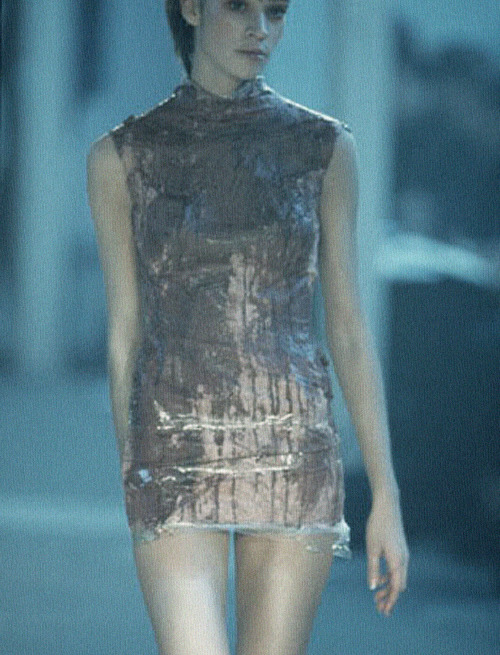Staged in October 1993, ‘Nihilism’ (which can be streamed in full here) was
Alexander McQueen’s S/S 1994 collection, and his first ‘official’ collection as
a fashion designer. The definition of the world ‘Nihilism’ itself comes from a
philosophical concept – its general philosophical definition is an ‘extreme
form of scepticism that denies all existence’, but it also holds the
psychiatric definition of ‘a delusion, experienced in some mental disorders,
that the world or one’s mind, body, or self does not exist’. This first collection
was an introduction to McQueen’s intelligent, philosophical take on fashion
design; perhaps one of the greatest things about McQueen is that researching
his work always allows a glimpse into the designer’s mindset and interests at
the time.
 |
| 'Blood-spattered dress', SS1994 |
The concept of Nihilism is visually represented
throughout the collection via translucent fabrics; sheer materials that glide
over the female form, allowing a glimpse at the flesh beneath. The element of
transparency represents that the clothes themselves are nothing – by stripping
the majority of the collection back and showing what were essentially chiffon sheaths,
the clothing itself may as well have no existence as it conceals little to none
of the body itself. Other outfits appeared to be made of cellophane (see above) that had
been wrapped tightly around the body and fitted with a zip in the back –
splattered with rust-coloured paint, the dresses looked like they had been
bleeding; the blood left to congeal. This kind of visual impact is the thing
that McQueen is renowned for; his references to the grotesque and the macabre
immediately set him apart from his contemporaries.
The McQueen woman is also a sexual being – but as
opposed to the flattering silhouette of an Alaia dress or the romantic curves
of Dolce & Gabbana, McQueen’s take on sexuality is far more aggressive. The
women walked the runway in men’s shirts that were unbuttoned to leave the
midriff completely exposed while they flicked their middle fingers at a crowd
of bemused fashion editors. The ‘Bumsters’ also made an appearance here –
trousers cut so low in the back that ‘bum cleavage’ (McQueen’s words!) were
visible. One variation of the bumster also saw the back of the trousers slashed
to reveal an expanse of female flesh; McQueen has often commented that he
wanted to elongate the arch of the back and accentuate the natural curve of the
body. The fact that the bumsters were teamed with cropped, high-neck metallic
tops meant that McQueen achieved his aim – everything else was covered apart
from the midriff. The combination of exposed buttock (provocative) and the
lingering focus on the arch of the back (sensual) epitomises McQueen’s view of
sexuality which combines beauty with provocation, a theme which reoccurs
frequently throughout his work.
| Example of the infamous 'Bumsters' |
The collection also featured several of the
sharp evening coats that he was renowned for, engineered with razor-sharp
lapels and asymmetric hemlines (see below for an example of McQueen’s earliest
work, ‘Jack the Ripper Stalks His Victims, 1992). The interesting thing about
McQueen’s tailoring is that he has always tailored from the side, meaning that
the coats are stiff at the back, creating a kind of tailcoat effect. This also
means that the coats follow the curve of the body exactly, coming in at the
waist and flaring out at the bottom, a dramatic silhouette which became a
signature of his early work. In this particular collection the coats were worn
with nothing underneath which, due to the lack of fastenings, meant that the breasts
were almost entirely exposed. Some of the coats also were made with unusual
hemlines – almost like a waistcoat with lapels added at the end, to leave the
behind exposed. The allusion to nudity appears to be an allusion to the concept
of nihilism – that the clothing didn’t exist, and the models were a blank
canvas.
 |
| Evening coat, 'Jack the Ripper Stalks His Victims' |
Overall, the collection was a beautiful introduction to Alexander McQueen and his method of design. The exaggerated silhouettes, the provocative behaviour of the models and the balance between aggression and romance were all to become signatures of the designer and his work – it’s fascinating to see that the imprint of the designer was so clearly marked on even his earliest work, showing clarity of vision and confidence in his work. The fact that he used philosophy and psychiatry to articulate the ideas behind his collections meant that he engaged intellectuals as much as he did the fashion crowd, and established him as a force to be reckoned with from the offset.
 |
| Small montage of the collection |

oye respeta esto es serio
ReplyDelete